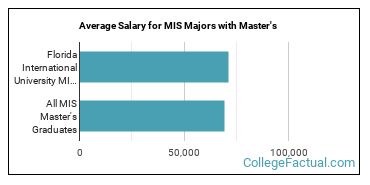 by our College Data Analytics Team
by our College Data Analytics TeamManagement Information Systems is a major offered under the business, management and marketing program of study at Florida International University. We’ve pulled together some essential information you should know about the master’s degree program in MIS, including how many students graduate each year, the ethnic diversity of these students, whether or not the degree is offered online, and more.
You can jump to any section of this page using the links below:
Out-of-state part-time graduates at FIU paid an average of $992 per credit hour in 2019-2020. The average for in-state students was $446 per credit hour. Information about average full-time graduate student tuition and fees is shown in the table below.
| In State | Out of State | |
|---|---|---|
| Tuition | $8,912 | $21,393 |
| Fees | $2,194 | $2,818 |
The median early career salary of MIS students who receive their master’s degree from FIU is $71,351 per year. That is 3% higher than the national average of $69,196.

Online degrees for the FIU MIS master’s degree program are not available at this time. To see if the school offers distance learning options in other areas, visit the FIU Online Learning page.
You may also be interested in one of these majors related to management information systems.
| Related Major | Annual Graduates |
|---|---|
| Business Administration & Management | 628 |
| Accounting | 107 |
| Finance & Financial Management | 80 |
| Hospitality Management | 169 |
| Human Resource Management | 122 |
*The racial-ethnic minorities count is calculated by taking the total number of students and subtracting white students, international students, and students whose race/ethnicity was unknown. This number is then divided by the total number of students at the school to obtain the racial-ethnic minorities percentage.
More about our data sources and methodologies.